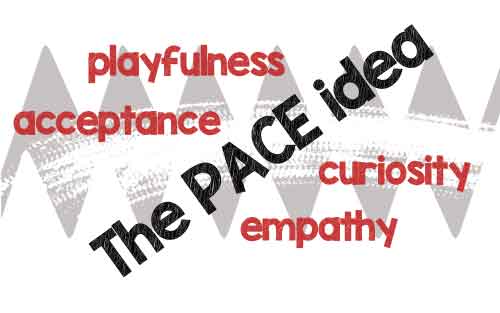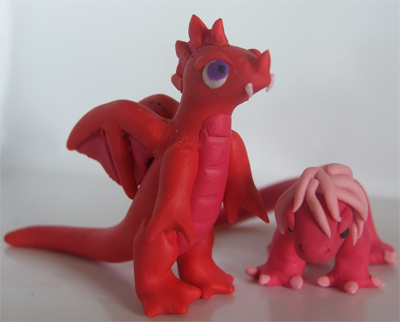- Home
- PACE ideas
How to Use PACE Ideas When You're a Parent of an Anxious Child
“PACE ideas” is how I describe these ideas for helping you engage with your anxious child. The reason is this.
PACE itself is an approach masterminded by Dan Hughes for use with traumatised children. Therapists, social workers and teachers use it and many therapists also help parents understand and use the principles, too – when your child's in therapy.
But the acronym is useful. It stands for four words that together are a great idea when spending time with your child. And especially so if you want to find out how they’re thinking, and to help them share their anxieties.
So I’m including this page on "PACE ideas" here. Dan Hughes is in no way responsible for anything I say, and I’m not claiming that this is in any way how he would use PACE with a traumatised child.
If you’d like to read more about Dan Hughes’ work, please look here.

PACE idea 1: P is for Playfulness
The idea of playfulness is quite different to being funny and making jokes all the time. It’s a kind of lightheartedness and enjoying yourself together with your child without being too serious. Here are some things you might be doing that show playfulness with a younger child:
- playing peek-a-boo
- dancing out the door when you go to the loo
- tickling their tummy when they hug you
- singing a silly nursery rhyme together as you both tidy up from lunch
- putting some handcream on their hands while you do yours
- expressing joyfulness at seeing a sparrow in the garden hopping around
You can see from these ideas that it’s far from being solemn and sober, and equally far from telling funnies. It’s about joy and fun and having a little giggle together. Or maybe a fantasy moment shared between the two of you.
In other words, any kind of playfulness that signals being together in an unconditional way.
The aim is to allow your child to relax and trust you and feel safe to tell you things they were finding difficult to say. In a different, playful atmosphere, this becomes possible.
You would obviously switch to careful listening if they shared something about their anxiety. But this bit is just about an attitude to take with them when life’s got a bit hard and you have special time together without distractions.
PACE idea 2: A is for Acceptance
As parents, it’s hard to always accept what our children tell us:
- Sometimes we don’t think they did the "right thing".
- Or else there’s a solution they "should have" thought of!
- Or perhaps we tell them not to “feel that way, it’s silly”.
The PACE idea of acceptance is to accept what your child is telling you. Calmly and quietly. We may not agree, but their feelings and motives are just that. Theirs. It won’t help them to say they were wrong!
That doesn’t mean accepting their behaviour if a boundary needs reinstating. But it does mean allowing them to be themselves “inside”.
I find it a good idea – for behaviour issues – to believe they're doing the best they can at the age they are with the skills they have. It’s a good starting point for a discussion. And improvement!
But beyond behaviour, well, “feelings” are not acts. If they say they’re scared or anxious, well they are. End of matter. We accept it and take it from there. Otherwise we induce guilt in them for having felt that way and shame for not being good enough. They then clam up.
So the idea of accepting their starting point, and their very inner being, is a good way forward when wanting to help them deal with anxieties and real-life problems.
After we
- accept them as they are,
- accept what they’ve said and
- have listened carefully,
we can show curiosity about what's going on for them.
There are a whole load of ways to help them deal with their anxiety if we can see a way forward now that will suit them. You can find these strategies scattered around this site on relevant pages, but also extra ones here.
Otherwise, read on to the next section to think about how we can show curiosity.
PACE idea 3: C is for Curiosity
Responses that show curiosity and are non-threatening (if phrased gently!) include things like:
- What do you think was going on for…?
- I wonder how…
- That’s an interesting one. Tell me a bit more…
- Help me understand how it looked from your point of view…
- What was that feeling like?
- I think I’d have felt a bit cross too – what else was going on?
Showing curiosity in this way, you can see that your child will feel
- relaxed enough to talk,
- accepted and understood, even if they suspect you don’t agree with what they said or did, and
- that you truly want to know how it was for them.
With a previously traumatised child, it’s obvious they'll need to continually be helped to feel like this over a period of time so that they gradually understand that not everyone is like the adults who traumatised them. They can then start to respond in different ways.
But with a child who's anxious about school, or going somewhere new, or getting things right – it’s just as important to use these PACE ideas, especially this attitude of curiosity. The PACE ideas act as a way into relating and conversation.
I know how easy it is to shout in frustration first and be curious second! But it’s so much more helpful if we can be curious first – and then the need to shout in exasperation will probably never arise!
PACE idea 4: E is for Empathy
The final PACE idea is to show empathy.
Empathy is not the same as sympathy! Empathy is understanding how it is for the other person – perhaps because we have an internal link to something similar (though it’s never exactly the same).
If you show empathy, your child will feel your compassionate care for them.
In our page on school issues, we mentioned that, in a survey of bullying victims, what most helped the children was
- being understood
- supportive listening
- receiving empathy and
- being prized as a worthwhile person.
The whole of the PACE idea here is to make this a reality so you’re in a position to help your anxious child and they’re in a position/disposition to start seeing a way forward with your help. But most of all, feeling connected to you by your response.
Help is great. But the important bit comes before the help – and includes all the PACE ideas above, including empathy.
To quote the DDP Network: “The adult is communicating strength, love and commitment, with confidence that sharing the child’s distress will not be too much. Together they will get through it.”
Brené Brown has a lovely very short YouTube RSA video on empathy here.
To quote her: “What makes something better is connection.”
And especially: “Rarely, if ever, does an empathic response start with "Well, at least...".”
IN CONCLUSION
I hope this run-through of PACE ideas will help you set up the sort of relationship with your anxious child that helps them move on to looking at how to overcome their anxieties.
Once you've set up a playful, accepting relationship demonstrating curiosity and empathy, it's fairly easy to help them look in detail at some ways forward. Some of the page links below might help.
Or you can click on symptoms, types or causes of anxiety on the menu tabs at the top. From there, you'll find many suggestions to help you help your child.
As ever, my help page will give you important information if you feel you need to choose a therapist to help your child.


